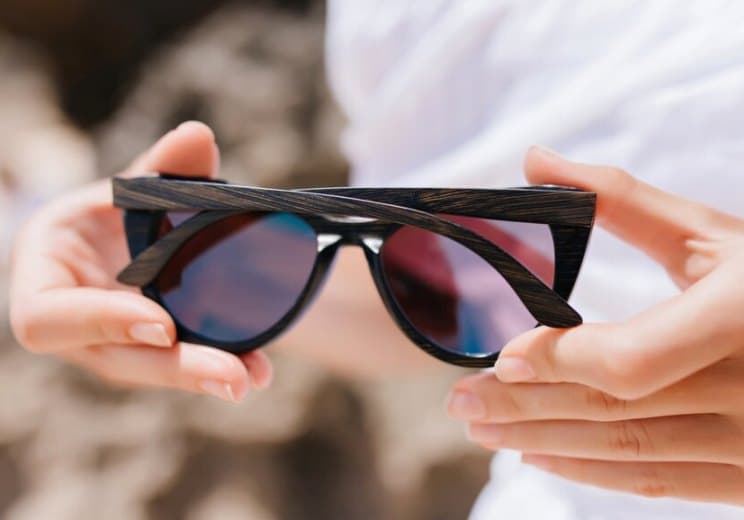When it comes to eyewear, two terms frequently come up: photochromic glasses and anti-glare glasses. Both technologies are designed to improve visual comfort and reduce strain, but they serve different purposes.
Photochromic glasses are known for their ability to automatically adjust to changing light conditions, darkening in bright sunlight and returning to clear indoors. They are ideal for those who frequently move between different lighting environments and want the convenience of not switching between prescription glasses and sunglasses.
On the other hand, anti-glare glasses, also known as anti-reflective glasses, are designed to reduce the reflection of light on the surface of the lenses. This technology helps minimize glare from screens, headlights, and other light sources, making it easier to see clearly and reducing eye fatigue, especially during prolonged use of digital devices or driving at night.
In this article, we’ll explore the key differences between photochromic and anti-glare glasses, how they function, and when you might want to choose one over the other.
Photochromic Glasses
Photochromic glasses, often referred to as transition lenses, are specialized lenses that automatically adjust their level of tint based on the surrounding light conditions.
Light-sensitive chemicals included in these lenses respond to UV rays from sunshine. When exposed to UV light, the molecules in the lenses undergo a chemical change that causes the lenses to darken. Conversely, when the light conditions diminish or when you’re indoors, the lenses return to a clear state.
The technology behind photochromic lenses is based on a chemical reaction triggered by ultraviolet rays. The lenses contain molecules such as silver halide or organic compounds. When exposed to UV light, these molecules rearrange themselves in a way that absorbs visible light, causing the lenses to darken. The darker the environment, the more the molecules rearrange, providing adequate protection from intense light.
Advantages of Photochromic Glasses
Photochromic glasses offer several advantages that make them a popular choice for people who need vision correction and spend time both indoors and outdoors.
Convenience
Photochromic lenses eliminate the need to switch between regular glasses and sunglasses. They function as both, adjusting automatically based on light exposure. This is especially convenient for those who are frequently moving between indoor and outdoor environments.
UV Protection
One of the biggest benefits of photochromic lenses is that they provide full protection against harmful UVA and UVB rays. Exposure to UV rays can cause long-term damage to the eyes, increasing the risk of cataracts and other eye conditions. Photochromic lenses block these rays without the need for separate sunglasses.
Reduced Eye Strain
Because photochromic lenses automatically adjust to changing light conditions, they reduce the need for your eyes to constantly adapt. This reduces eye strain and fatigue, particularly when transitioning between bright outdoor light and dim indoor environments.
Enhanced Visual Comfort
In bright sunlight, photochromic lenses darken to reduce glare, providing more comfortable vision. This is particularly beneficial when driving, walking outdoors, or engaging in activities where harsh sunlight might cause discomfort.
Cost-Effective
While photochromic glasses may initially cost more than regular prescription glasses, they save money in the long run by eliminating the need for a separate pair of prescription sunglasses. You get both in one set of lenses.
Disadvantages of Photochromic Glasses
While photochromic glasses offer numerous advantages, they also come with certain disadvantages that may affect their suitability for some users. Here are the key drawbacks of photochromic lenses:
- Transition Speed: One common issue is that these lenses can take a few moments to adjust when moving between environments with drastically different light conditions, such as going indoors from bright sunlight.
- Effectiveness in Vehicles: Since car windshields block most UV rays, photochromic lenses may not darken properly inside a vehicle.
- Weather Sensitivity: They tend to perform less effectively in extremely cold weather, where the lenses may take longer to transition back to clear.
- Limited Color Options: Most photochromic lenses tend to darken to a gray or brown tint. This may limit options for those looking for specific colors to match their style or personal preferences.
- Not a Substitute for Sunglasses: For individuals who spend extended periods in direct sunlight or engage in activities like skiing or fishing, photochromic lenses may not provide adequate protection. They typically do not get as dark as traditional sunglasses, which can lead to discomfort in bright conditions.
Anti-Glare Glasses
Anti-glare glasses are designed to reduce the glare and reflections that can impair your vision, particularly from artificial light sources like screens, headlights, and streetlights. These glasses feature a microscopically thin coating on the lenses that eliminates the reflections on both the front and back surfaces of the lens.
The anti-glare coating works by using destructive interference, a phenomenon in which light waves cancel each other out. The coating minimizes the amount of light that is reflected from the surface of the lens, allowing more light to pass through the lens and improving vision clarity, particularly in low-light conditions or when looking at digital screens.
Advantages of Anti-Glare Glasses
Here are the key advantages of anti-glare glasses:
Reduced Glare
Anti-glare coatings minimize reflections on the surface of the lenses, allowing more light to enter the eyes. This results in clearer vision, especially in bright environments or when using screens.
Improved Night Vision
For individuals who drive at night, anti-glare glasses help reduce glare from oncoming headlights and streetlights. This can improve night vision and overall safety while driving in low-light conditions.
Aesthetic Appeal
Anti-glare lenses look clearer because they reduce visible reflections. This makes your eyes more visible behind the lenses, which is a common concern for people who wear glasses for presentations or photos.
Reduced Risk of Eye Fatigue
The reduction in glare and reflections can help prevent eye fatigue during prolonged periods of use, whether working on a computer, reading, or engaging in other activities that require focused vision.
Digital Eye Strain
Ideal for reducing the discomfort caused by staring at screens for prolonged periods, which is commonly referred to as computer vision syndrome.
Protection Against Scratches
Many anti-glare lenses come with additional scratch-resistant coatings, enhancing the durability of the glasses. This can help maintain clarity and prolong the lifespan of the lenses.
Disadvantages of Anti-Glare Glasses
While anti-glare glasses (or anti-reflective lenses) offer numerous benefits, they also come with certain disadvantages that potential users should consider. Here are some key drawbacks of anti-glare glasses:
Higher Cost
Anti-glare glasses typically increase the overall cost of lenses compared to standard glasses. While they provide benefits, the added expense may not be justifiable for everyone.
Durability Concerns
Over time, the anti-reflective coating can wear off or become damaged, particularly with frequent cleaning. This may result in peeling, discoloration, or a reduction in effectiveness, necessitating replacement.
Reflections from Light Sources
In some cases, users may experience a “halo” effect or distortion around lights, especially in low-light conditions. This can be distracting and may impact visual comfort.
Key Differences Between Photochromic and Anti-Glare Glasses
After discussing the principles of both technologies, let’s examine the main distinctions between anti-glare and photochromic glasses:
Purpose
Photochromic glasses are primarily designed to adapt to changing light conditions. They darken when exposed to sunlight and clear up indoors.
Anti-glare glasses, on the other hand, focus on reducing reflections from artificial light sources, improving visual clarity, especially in low-light or screen-heavy environments.
Use Case
If you spend a lot of time outdoors and don’t want to switch between regular and sunglasses, photochromic lenses are the better option.
For those who work in front of screens for extended periods or drive frequently at night, anti-glare glasses are the best choice. They minimize digital eye strain and enhance visibility in low-light conditions.
Light Sensitivity
Photochromic glasses react to UV light, meaning they may not transition effectively inside cars or under artificial lighting conditions.
Anti-glare glasses are useful in environments with artificial lighting, such as office spaces or while using devices like laptops, smartphones, and televisions.
Aesthetic Considerations
Some users prefer the seamless transition of photochromic lenses, as they adjust automatically to outdoor light and provide UV protection without needing a separate pair of sunglasses.
On the other hand, anti-glare glasses offer a more polished look, particularly in settings with a lot of artificial light. The absence of reflections makes the lenses look clearer, which enhances the appearance of your eyes in photographs or during video calls.
Cost and Availability
Both types of glasses can be costly, but photochromic lenses tend to be pricier due to the complexity of the technology involved.
Anti-glare coatings add to the cost of regular lenses but are generally more affordable than photochromic lenses.
Which Should You Choose Between Photochromic And Anti-glare Glasses?
When deciding between photochromic and anti-glare glasses, consider your lifestyle and specific visual needs. If you spend a significant amount of time outdoors and need protection from UV rays, photochromic glasses are a convenient, all-in-one solution.
However, if you work in front of screens or frequently drive at night, anti-glare glasses may offer you the visual clarity and comfort you need.
In some cases, you may even benefit from a combination of both. Some manufacturers offer glasses that feature photochromic lenses with anti-glare coatings, providing the best of both worlds. This option is ideal for individuals who need day-to-night vision correction without compromising on clarity or comfort.


